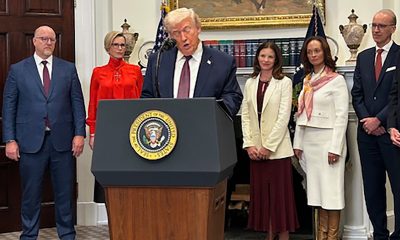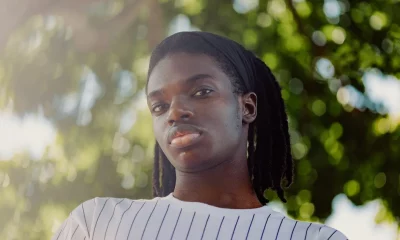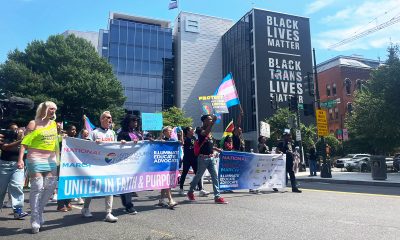Opinions
The harm of excluding queer history in schools
Stories of unapologetic LGBTQ+ figures inspire queer youth


The majority of high school students can rattle off facts about the lives and legacies of figures like Thomas Jefferson and Alexander Graham Bell, but can’t do the same for Marsha P. Johnson, Harvey Milk, or Leslie Feinberg. This is because in today’s school system, the contributions of key LGBTQ+ civil rights leaders and the movements they lead aren’t taught. This exclusion of queer history, coupled with the leaving out of LGBTQ+ inclusive sex education, affects all students in negative ways.
Being forced to seek information about people like us in the past and different sexual orientations as we figure ourselves out is incredibly alienating. Because I had never been given information about it anywhere, I thought of being queer as something that I shouldn’t and couldn’t be.
If I had been educated in school about these things, it would have been easier for me to recognize what I was feeling and realize that it was “normal” and natural for me. This is an experience that I share with many other LGBTQ+ youth, including my friends and classmates.
“I didn’t know it was possible to like girls, let alone like girls and boys, or to not be a girl or a boy until I did my own research on it,” says 16-year-old Willa, who is non-binary and pansexual. “It definitely hindered my journey in discovering myself.”
Fifteen-year-old JB Campbell, who is non-binary and biromantic, says: “There were many internal signs that would’ve made my journey easier had I been exposed to representation and had a chance to understand things that weren’t considered the norm.”
Furthermore, the representation of queer individuals in history who did groundbreaking things for the LGBTQ+ community will show students that people’s contributions to the world we live in now hold the same value as other historical events that shaped the way we live today. If we teach students about the pioneers of the queer rights movement who fought against police brutality at Stonewall and the HIV/AIDS epidemic, queer students are less likely to feel that their lives and experiences are less important because of who they are. Representation matters, and the stories of unapologetic LGBTQ+ figures inspire queer youth to be proud of who they are.
The narrative of the way that the LGBTQ+ community has been erased and devalued throughout history and how we’ve worked to overcome this inequity is a lesson that is beneficial to all students, according to teacher Colin O’Grady.
“When people see themselves represented in history, or in literature, it validates their sense of self-worth. It tells them that their lives matter and that they are valued members of society,” he says. “Revising the curriculum to be more inclusive, and teaching about the exclusion from historical narratives that occurred up until now also teaches all students a lot about the nature of how history is constructed and leads them to think critically about the narratives that they encounter.”
Students who are aware of the injustices faced by the queer community and how they shape our lives are better equipped to question inequality in their daily lives.
History being taught through a solely cisgender and heterosexual lense creates a stigma around queerness that affects cishet student’s perception and understanding of their LGBTQ+ peers. For students who grow up in homophobic and transphobic households, the only image they’re likely to have of the queer community is that we’re “weird” or “gross,” and this is harmful to both their queer peers and themselves. “I’m straight myself, but I have many LGBTQ+ friends and I want to do as much as I can for them,” says 16-year-old J. “I think if they had taught us about this in school, we’d definitely be more accepting.”
GLSEN’s 2017 National School Climate Survey found that 91 percent of LGBTQ+ students in Virginia secondary schools heard their classmates use the word “gay” in a derogatory way. Eighty-one percent had heard their classmates use homophobic slurs, and 73 percent had heard negative comments about transgender people.
If we’re taught from the beginning that queer people exist and are human beings who make valuable contributions to society just like everyone else, students who use the word “gay” as an insult and view being queer as something that’s unnatural and wrong would be less inclined to do so. If the etymology behind homophobic and transphobic slurs are included in the curriculum, cishet students who use these words against their queer peers would be likely to stop after they’re given the understanding of the true weight that they hold.
Only 15 percent of queer Virginia students who were surveyed by GLSEN in 2017 said that they were taught about the queer community in a positive light, and 3 percent said that the sex education they had received was LGBTQ+ inclusive.
As well as making queer students more comfortable, LGBTQ+ inclusive sex education would improve the safety of queer students, both physically and mentally.
According to a report by the Centers for Disease Control and Prevention, 70 percent of new HIV cases were made up of gay and bisexual men in 2017. Sixty-four percent of those new cases were men between the ages of 13-34. A 2003 study by the University of Washington found that almost half of women who had intercourse with women in the past year tested positive for herpes simplex virus type one.
In order to lower these numbers and give queer students comparable health benefits from their health classes, students need to be educated about Pre-Exposure Prophylaxis (PrEP), dental dams, and STDs that disproportionately affect those who engage in same-sex intercourse.
As it is today, the majority of sex education curriculums include no mention of sexual orientation or gender identity. When these things are brought up, they’re often portrayed in a negative way. This contributes to the frequent bullying and discrimination that queer students face due to the LGBTQ+ exclusive climate cishet-only sex education generates. The Center for American Progress reported that almost one-third of LGBTQ+ students have skipped class because they felt unsafe at school. The negative bias around being LGBTQ+ that is caused by only portraying queerness in a negative light makes queer students miss out on academic opportunities and fall behind in their education.
Excluding queer student’s history and sex education doesn’t do any good for them or their cisgender and heterosexual counterparts. The stories of strong LGBTQ+ leaders and how they broke barriers teach lessons that everyone can learn from, and normalize queer identities and relationships. Inclusive sex education gives queer students the same tools as their classmates to make informed and safe choices.
Maeve Korengold, 16, is a high school junior and Safe Space NOVA’s newest Student Ambassador.
Opinions
Support the Blade as mainstream media bend the knee for Trump
From CBS to Washington Post, MAGA taking over messaging

We knew it would be bad. I’m referring, of course, to 2025 and the unthinkable return of Donald Trump to the White House.
We just didn’t know how bad. The takeover of D.C. police. ICE raids and agents shooting defenseless citizens in the face. The cruel attacks on trans Americans. A compliant and complicit right-wing Supreme Court and GOP rubberstamping all the criminality and madness.
Much of that was outlined in Project 2025 and was predictable. But what has proven surprising is the speed with which major companies, powerful billionaires, and media conglomerates have hopped on board the authoritarian train and kissed Trump’s ring. Tech giants like Apple and Meta and media companies like CBS and the Washington Post have folded like cheap tents, caving to MAGA pressure and enabling Trump’s evil agenda.
The guardrails collapsed in 2025. Congress has ceded its role as a formerly co-equal branch of government. Once trusted media outlets have betrayed their audiences’ trust and morphed into propaganda arms of the White House. As a lifelong journalist, this is perhaps the most shocking and disappointing development of the past year.
The Washington Post, which adopted the ominous tagline of “Democracy Dies in Darkness,” killed its endorsement of Kamala Harris in the final days of the 2024 campaign. Same thing at the Los Angeles Times. More recently, CBS’s vaunted “60 Minutes” spiked a story critical of Trump’s immigration policies under the direction of new editor-in-chief Bari Weiss, a Trump toady and the antithesis of a journalist.
Concurrently, media companies large and small are fighting to survive. Government grants have been rescinded and the Corporation for Public Broadcasting, responsible for funding NPR and PBS, announced plans to dissolve. The Pittsburgh Post-Gazette, a nearly century-old Pulitzer Prize-winning institution, announced this week it will close on May 3. The Washington Post has lost scores of talented journalists, including prominent LGBTQ voices like Jonathan Capehart. The Baltimore Sun was acquired by the same family that owns right-wing Sinclair Broadcasting, ending a nearly 190-year tradition of award-winning, independent journalism.
It is not a coincidence that Trump’s attacks on democracy, traditions, and norms are happening while the media industry collapses. News deserts are everywhere now. In 2024, 127 newspapers closed, leaving 55 million Americans with limited or no access to local news, according to a report by Medill.
There’s a reason the media are called the “Fourth Estate.” Journalism was considered so critical to the health of our democracy that the Founding Fathers spelled it out in the First Amendment. Democracy and our Constitution cannot survive without a free and robust press.
That’s why I felt compelled to write this appeal directly to our readers. For nearly 57 years, the Blade has told the stories of LGBTQ Washington, documenting all the triumphs and heartbreaks and writing the first draft of our own history. Today, we remain hard at work, including inside the White House. This week, we have a reporter on the ground in Colombia, covering the stories of queer Venezuelan migrants amid the crisis there; another reporter will be inside the Supreme Court for next week’s trans-related cases; on Sunday, we have a reporter on the red carpet at the Golden Globes ready to interview the stars of “Heated Rivalry.”
We do a lot with a little. As major companies pull back on their support of the LGBTQ community, including their advertising in the Blade, we turn to our readers. We have never charged a dime to read the Blade in print or online. Our work remains a free and trusted resource. As we navigate these challenges, we ask that you join us. If you have the resources, please consider making a donation or purchasing a membership. If not, please subscribe to our free email newsletter. To join, visit washingtonblade.com and click on “Fund LGBTQ Journalism” in the top right navigation.
Our community is known for its resilience. At the Blade, we’ve weathered the AIDS epidemic, financial crises, and a global pandemic. We are committed to our mission and will never bend to a wannabe dictator the way so many mainstream media outlets have done. The queer press is still here and with your help we will survive these unprecedented attacks on democracy and emerge stronger than before. Thank you for reading the Blade and for considering making a donation to support our work.
Kevin Naff is editor of the Washington Blade. Reach him at [email protected].
Opinions
Time has run out for the regime in Venezuela
American forces seized Nicolás Maduro, wife on Jan. 3
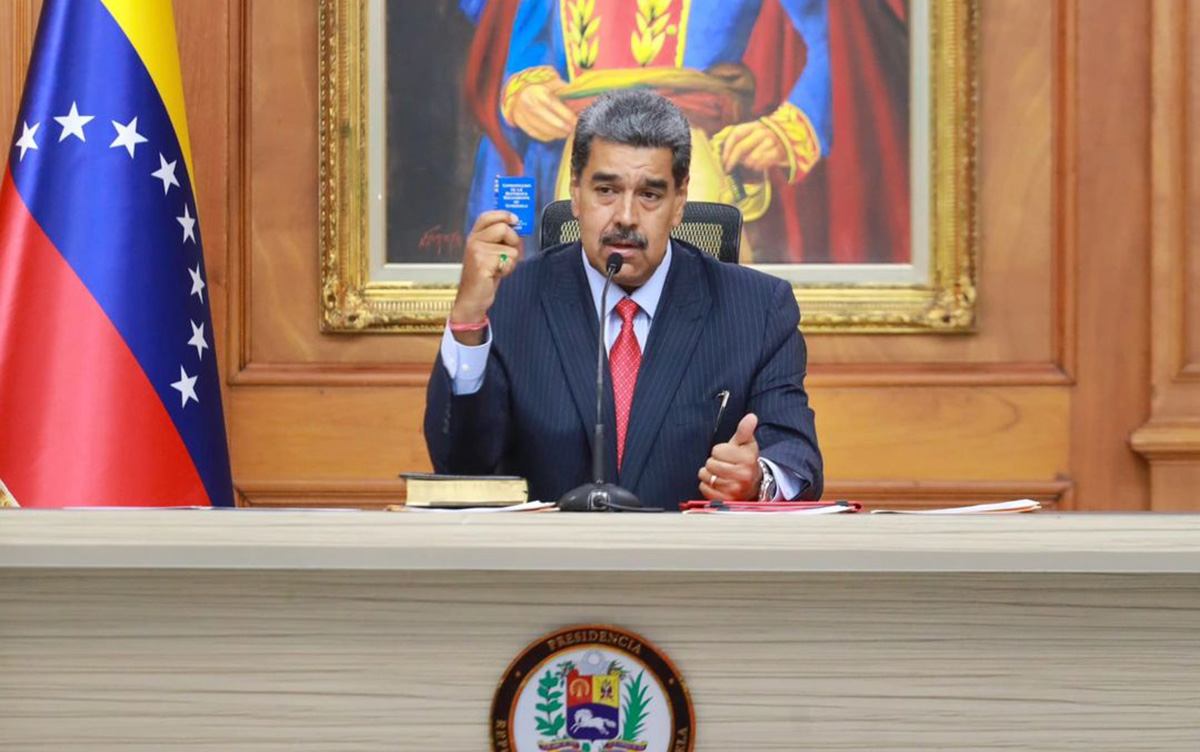
Time has run out for the regime in Venezuela.
I am fully aware that we are living through complex and critical days, not only for my country but also for the entire region. However, the capture of Nicolás Maduro has renewed hope and strengthened my conviction that we must remain firm in our cause, with the certainty that the valid reward will be to see Venezuela free from those who continue to cling illegitimately to power.
In light of this new reality, I adopt a clear, direct, and unequivocal position:
I demand the immediate release of all political prisoners.
I demand that all persons arbitrarily detained for political reasons be returned to their families immediately, without delay or conditions.
According to Foro Penal, as of Jan. 5, 2026, there are 806 political prisoners in Venezuela, including 105 women, 175 military personnel, and one adolescent, and a total of 18,623 arbitrary arrests documented since 2014. The same report documents 17 people who have died while in State custody and 875 civilians prosecuted before military courts, clearly evidencing the use of the judicial and security apparatus as instruments of political persecution. In parallel, the humanitarian system estimates that 7.9 million people in Venezuela require urgent assistance, further aggravating the impact of repression on daily life.
Behind these figures are shattered lives, separated families, and destroyed life projects. Students, activists, human rights defenders, political leaders, and members of the armed forces remain imprisoned without judicial guarantees, without due process, and without justice.
Since the capture of Nicolás Maduro, repression has not ceased. On the contrary, more than ten journalists have been arbitrarily detained, while others have been harassed, imprisoned, or mistreated for carrying out their duty to inform. Today, journalism in Venezuela has become a heroic and high-risk act.
This situation is further aggravated by a new attack on fundamental freedoms: an illegitimate decree of “external state of emergency”, whose purpose is to legalize state terrorism, expand the scope of repression, and deepen the criminalization of dissent and freedom of expression.
The destruction of freedoms cannot and must not be normalized, either by society or by the international community.
I do not forget the atrocities committed against people deprived of their liberty: systematic violations of due process, torture, cruel, inhuman, and degrading treatment, denial of medical care, and prolonged isolation.
These practices have been widely documented and denounced and are currently under investigation by international justice mechanisms.
In this regard, the United Nations Independent International Fact-Finding Mission on Venezuela has repeatedly expressed grave concern over the persistence of serious human rights violations, including the use of torture, enforced isolation, and the responsibility of State security forces in systematic abuses, as reflected in its statements and reports issued on Jan. 3, 2026, and throughout 2025.
From my unwavering commitment to human rights, I issue a firm and urgent call to Venezuelan citizens and to all people in the free and democratic world to stand together in defense of human dignity.
All political prisoners must be released now.
All torture and detention centers must be closed.
I am convinced that there can be no genuine democratic transition without the immediate release of political prisoners, the submission to justice of those responsible for arbitrary detentions, and the establishment of accountability mechanisms, guarantees of non-repetition, and full reparation for victims and their families. This is the only viable path toward a proper transition to democracy in Venezuela.
Today, more than ever, I stand in solidarity, inside and outside Venezuela, with the victims and their families.
This is a moment of definition, not of silence or hesitation.
I assume, together with millions of Venezuelans, that we are co-responsible for our collective reality and for the new Venezuela that we are called to rebuild.
Dignity, freedom, and justice cannot wait.
Freedom for Venezuela.
Juan Carlos Viloria Doria is president of the Global Alliance for Human Rights and vice president of Venezolanos en Barranquilla, an NGO based in Barranquilla, Colombia.
Opinions
Just say no to the felon in the White House
Democrats, media must do more to oppose Trump’s agenda
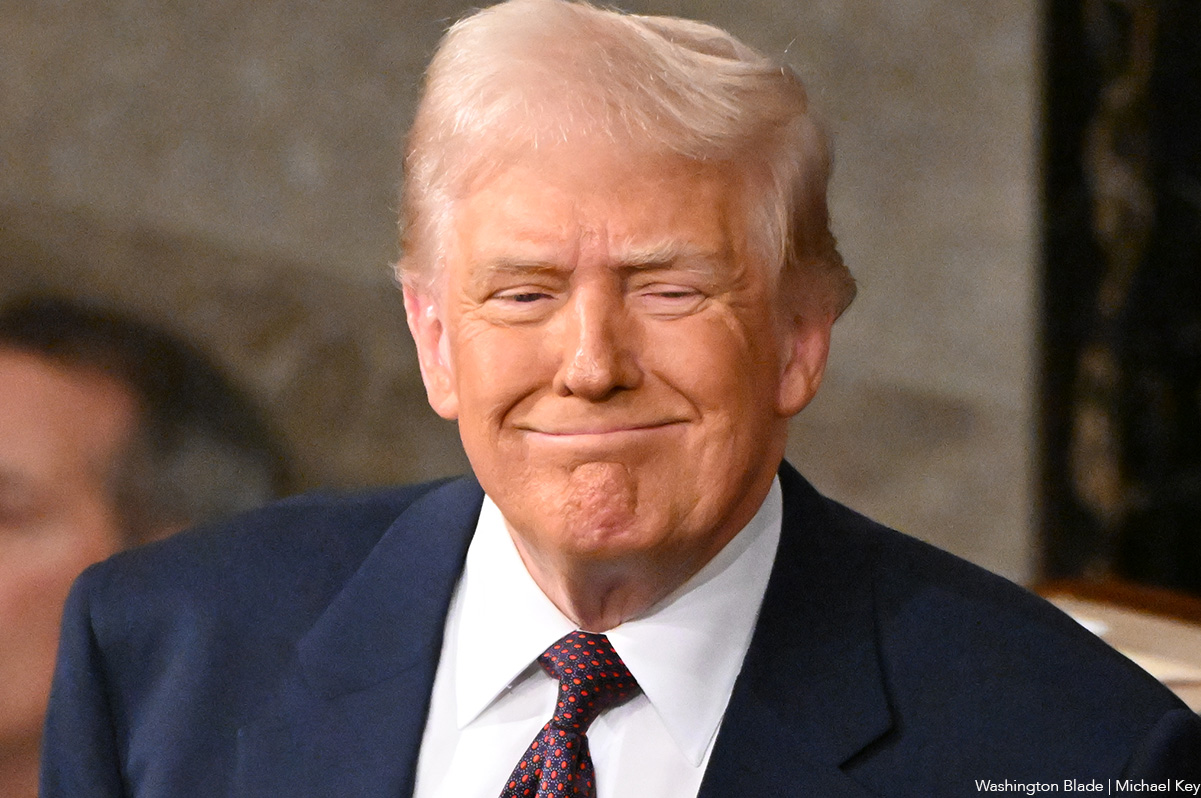
We have a clearly deranged, sick, felon as president, who can’t even remember if he had an MRI, or a CT. He says he takes enough aspirin to keep his blood running thin in his veins. He fakes health reports, and lies every time he opens his mouth. His brain appears foggier than Joe Biden’s ever was.
The felon arranged to get a fake Peace Prize from the soccer federation, while taking military actions around the world. He sanctioned American attacks on Nigeria, Iran, Syria, and now on the government, and people, of Venezuela. He has our military attacking boats, claiming they are carrying drugs, with no proof. He interferes in foreign elections, making the United States less safe. He obviously supports Putin in his war against Ukraine, and supports Netanyahu’s destruction of Gaza, and his starvation of the Palestinian people there. Because of all this it’s understandable why he calls his Secretary of Defense, his Secretary of War. That individual being unqualified with no competence, or decency — the perfect toady for the fascists surrounding Trump. He has a Secretary of State in Marco Rubio who clearly has no principles at all. Rubio previously said, “Donald Trump – a con artist – will never get control of this party…We cannot allow a con artist to get access to the nuclear codes of the United States of America.” He compared Trump to a “third-world strong man.” Now as Secretary of State he justifies all the illegal actions the felon takes.
I, and many others, question “Where is Congress in all this?” Do no Republicans in Congress have any cojones? Two Republican woman have criticized Trump — Marjorie Taylor Greene (R-Ga.) and Nancy Mace (R-S.C.). Both on the Epstein files, one on screwing the American people with regard to their health insurance. Both are now out of Congress, still MAGA, but found if you disagree with the felon, he sics his cult on you.
My other question is: When will any in the media really stand up to him? When do mainstream media call out every one of his lies, as he makes them? When do they show any guts, and repeat each day he is deranged? When do they have daily headlines, calling him out on things from his health reports, to lies about the economy? Where are the daily headlines calling out the Republican Congress for its lack of action? Why is there no representative clock on every TV network, ticking off the time Congress doesn’t take back their rightful place as an equal branch of government? When will they call out the Supreme Court, reminding people what Trump’s picks said during their confirmations, versus what they are doing now? When will they actually reclaim ‘The freedom of the press?’
Democrats must continue to speak out. I am aware they have little power in this Congress, but they must not remain silent. We have seen, when they do speak up, we win elections. They help the people to wake up, as they did in recent elections in New Jersey and Virginia. In races as distinct as the mayoralty of Miami, where a Democrat won for the first time in 30 years, and did so in a landslide; and Democrats won two special elections for State Senate in Mississippi. In Georgia, Democrats won two seats on the Georgia Public Service Commission, the first time in 20 years they won a statewide seat. And they won a State Senate seat in Iowa, and the redistricting vote in California.
To continue winning Democrats must remind people every day what the felon, and his fascist cohorts, are doing to destroy their lives. Latinos and Hispanics need a daily reminder, it is the felon who once said he supports them, whose government is now deporting them. Young people must be reminded every day, the felon is destroying the country they will inherit, their future, by denying climate change. Everyone needs daily reminders how he is destroying the health of the country. Ending research grants looking for cures for cancer, Alzheimer’s, Parkinson’s, and HIV/AIDS. Ending research grants into curing childhood diseases, development of mRNA vaccines, and other potential progress to protect Americans, and the world, when the next pandemic occurs, and it will. He is literally killing children by having his government speak out against vaccinations for illnesses like measles, considered eradicated before he came into office.
All of this needs to be headlined each day in our newspapers, and on TV, by the people who still can, and are willing, to do it. Those not bought off by, or afraid of, the felon, and his fascist cohorts. Those who don’t sit with him at Mar-a-Lago, and have become his enablers. We the people need to take to the streets and every time there is an election, use our vote to say to the sick, deranged, felon, and his fascist cohorts, ‘NO MORE’.
Peter Rosenstein is a longtime LGBTQ rights and Democratic Party activist.
-

 National5 days ago
National5 days agoWhat to watch for in 2026: midterms, Supreme Court, and more
-

 Opinions5 days ago
Opinions5 days agoA reminder that Jan. 6 was ‘textbook terrorism’
-

 District of Columbia5 days ago
District of Columbia5 days agoImperial Court of Washington drag group has ‘dissolved’
-

 Colombia4 days ago
Colombia4 days agoGay Venezuelan man who fled to Colombia uncertain about homeland’s future

